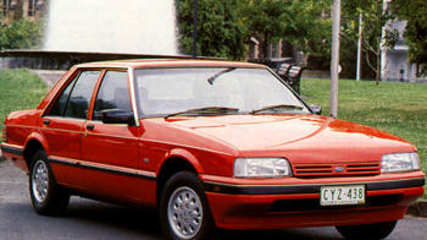Used Ford Falcon review: 1984-1987
By Graham Smith · 23 Jan 2009
Ford was riding high when the XF was launched in 1984. The blue oval brand had a stranglehold on market leadership at a time when its lionhearted rival was teetering on the brink of oblivion. The XF was top dog with almost 280,000 sold during its three-year reign at the top.Ford entered the 1980s in better shape than Holden. Its response to the oil crises of the ’70s was to make its cars lighter and more fuel efficient, and the square XD of 1979 was the result. Holden instead downsized to the Commodore but stuck with its old and inefficient engines, and suffered as a result.The XF was the last of the square Falcons that kicked off with the XD, and was the best. Roomy inside, with upgraded dashes, and with more frugal engines the facelifted Falcon was the most popular choice in the mid-1980s.It was also a popular choice as a secondhand car up until a couple of years ago, and is now one of the cars considered by families as a solid and reliable first car for their young drivers.MODEL WATCHThe new front and rear treatment, with colour-coded bumpers, gave the XF more rounded and friendlier lines than the earlier XD and XE models. Inside it was quieter and more refined, and had a new dash layout, with better ergonomics, and there were improvements to the heating and ventilation, and air-conditioning systems.Mechanically the most significant change was the introduction of the EEC-IV electronic engine management system that better controlled the spark and fuel for improved fuel economy and drivability.The heads had larger intake valves and new high swirl combustion chambers that also contributed to the better fuel consumption.Three sixes were offered, but there was no V8 after that had been dropped in 1983. The 3.3-litre base engine gave 90 kW at 4100 revs, the 4.1-litre six 103 kW at 375o revs, and the new 4.1-litre EFI engine, with 120 kW at 4000 revs was the engine Ford offered V8 owners.The 3.3-litre six was available with a choice of three-speed column shift, and four and five-speed floorshift manual gearboxes, and a three-speed auto. The 4.1-litre six had the choice of four and five-speed floorshift manuals, and the three-speed auto, while the EFI engine came standard with the auto.An update in 1986 saw four-wheel discs and power steering become standard, and the option of a five-speed manual gearbox was offered with the EFI engine.IN THE SHOPExpect the worst, hope for the best, and seek expert advice. That’s the approach to take with a car as old as the XF Falcon. It’s not that it was a bad car, far from it, but the reality is that most of them are at the end of the road in terms of useful life.The Falcon was a tough old bird when it was new, tougher than the Commodore of the time, but that means it was bought to work. It made a good towing vehicle, particularly the wagon, which still had the leaf spring rear end under it, and many were made to work hard.If it’s fitted with a tow bar, check for signs of hard use. If you think it’s been given a hard time don’t buy it. Look for the car that’s been pampered, the one that’s been garaged and hasn’t got heaps of kays on the odometer.The most popular engine was the 4.1-litre six so that’s the one you’re most likely to find now. It’s a strong willing workhorse, but like all alloy-headed Falcon sixes needs clean coolant to minimise the chances of head gasket problems. Check for corrosion in the cooling system.The smaller 3.3-litre six wasn’t as popular with Falcon buyers, but was quite economical and is worth considering now if you want thrifty transport and you’re not too worried about towing.The pick of the bunch is the fuel-injected version of the 4.4-litre engine, if you can find one.Many XFs have been converted to LPG. They take to LPG well, but make sure you thoroughly check the LPG system fitted to any car you might think about buying. If you’re not sure get an expert to go over it.Look also for worn front-ends, and engine oil leaks and rattles.Rust isn’t a huge problem, except on wagons around the rear liftback, but faded paint is common. It’s particularly a problem with metallic colours, and even some solid colours. White stands the test of time best, and a white XF can look sharp even now.There is plenty of plastic on the inside and you can expect that this will be cracked or distorted from exposure to the sun over the years.LOOK FOR:• High kays, loose front-ends, rattly engines.• Faded paint, cracked and buckled plastic parts inside• Wagon makes a tough tow car.• Spend time to find the best car.• One that’s been pampered.• Roomy and comfortable interior.• EFI six is best choice.• Clean coolant and no corrosion in cooling system






